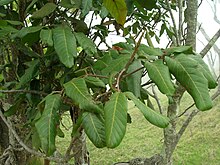Alectryon macrococcus
| Alectryon macrococcus | |
|---|---|

| |
| A. m. var. auwahiensis | |
| Scientific classification | |
| Kingdom: | Plantae |
| Clade: | Tracheophytes |
| Clade: | Angiosperms |
| Clade: | Eudicots |
| Clade: | Rosids |
| Order: | Sapindales |
| Family: | Sapindaceae |
| Genus: | Alectryon |
| Species: | A. macrococcus
|
| Binomial name | |
| Alectryon macrococcus | |
Alectryon macrococcus, known as ʻAlaʻalahua or Māhoe in
Their leaves are each made up of oval-shaped, asymmetrical, net-veined leaflets. Variety auwahiensis has leaflets with rusty-red undersides.[4] The fruits contain a seed with a bright red aril. More than a century ago, it was noted that Native Hawaiians ate the fleshy, insipid and slightly sweet arils and mildly flavored seeds.[5]native Hawaiians.[4] The seeds also attract rats, whose consumption of them prevents the plants of this endangered species from reproducing.[4] The black twig borer (Xylosandrus compactus) destroys the twigs.[6]
Alectryon macrococcus var. auwahiensis has been found growing naturally only (endemic) in Maui, where it grows in
Alectryon macrococcus var. macrococcus inhabits mesic forests at elevations of 365–1,035 m (1,200–3,400 ft) on Kauaʻi, Oʻahu, Molokaʻi and western Maui.[9][10][11][12]
References
- . Retrieved 12 November 2021.
- ISBN 9780824821661.
- ^ Donald R. Hodel (2015). "Trees in the Landscape, Part 11: Alectryon excelsus subsp. excelsus" (PDF). PalmArbor. 2015 (1): 1–13.
- ^ a b c "Alectryon macrococcus var. auwahiensis". CPC National Collection Plant Profile. Center for Plant Conservation. Archived from the original on 2010-10-28. Retrieved 14 Dec 2013.
- ISBN 0804811407.
- ^ "Comprehensive Report Species - Alectryon macrococcus". The Nature Conservancy. Retrieved 14 Dec 2013.
- ^ Bruegmann, M.M.; Caraway, V. (2003). "Alectryon macrococcus var. auwahiensis". . Retrieved 12 November 2021.
- ^ "ʻAlaʻalahua, mahoe; Alectryon macrococcus var. auwahiensis" (PDF). Comprehensive Wildlife Conservation Strategy. State of Hawaiʻi. Archived from the original (PDF) on 2013-11-03. Retrieved 14 Dec 2013.
- ^ a b
Linney, G. (1987). "Nomenclatural and taxonomic changes in Hawaiian Alectryon (Sapindaceae)". Pacific Science. 41 (1–4): 68–73. hdl:10125/1021.
- ^ a b
St John, H.; Frederick, L. (1949). "A Second Hawaiian Species of Alectryon (Sapindaceae): Hawaiian Plant Studies 17". Pacific Science. 3 (4): 296–301. hdl:10125/8938.
- ^ Bruegmann, M.M.; Caraway, V. (2003). "Alectryon macrococcus var. macrococcus". . Retrieved 12 November 2021.
- ^
"Taxon Summary: Alectryon macrococcus var. macrococcus" (PDF). Final Implementation Plan for Mākua Military Reservation, Island of Oʻahu. University of Hawaii at Manoa. Retrieved 14 Dec 2013.
External links
![]() Media related to Alectryon macrococcus at Wikimedia Commons
Media related to Alectryon macrococcus at Wikimedia Commons

